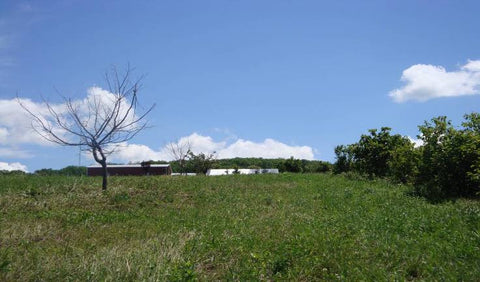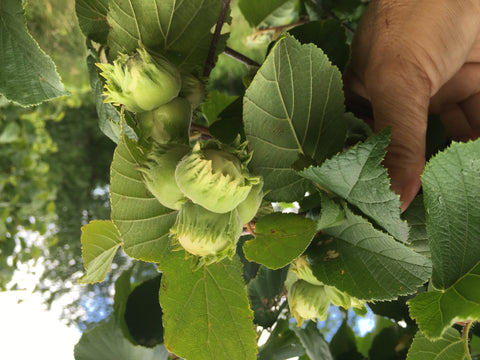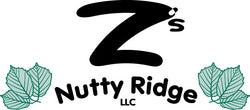About Hazelnuts - Natures Native Power Plant

Introducing the Locally Grown Hazelnut
Tasty heart healthy hazelnuts are used in many food products desired by consumers and are chronically in short supply. People are surprised to learn that hazels are a native tree that grows locally in the wild. Yet, most all hazelnuts are sourced from either Oregon or Turkey. This informative sheet reviews why hazelnuts have not been grown locally and why Z’s Nutty Ridge LLC will now usher in this new profitable desired crop. We only sell clones of our best trees or seedlings from our best trees so supply is limited.
“Hazelnuts are a new crop 96 years in the making”
Why grow Hazelnuts?
American Hazelnuts (Corylus americana) are native to the whole North East to Central United States and Southern Canada as shown in the map below in Figure #1a. The hardy native hazel bushes harbor a blight known as Eastern Filbert Blight (EFB) caused by the fungus Anisogramma anomala. Native hazels are unaffected by the blight; but, the nuts are tiny, go unnoticed in the wild and are undesired for consumption. European hazelnuts (a.k.a. Filberts) have been selected for production with large tasty nuts for hundreds, even thousands of years. However, the European hazels (Corylus avellana) generally are not as hardy and are often severely distressed or killed by EFB.


Fig. 1a Native hazel range. Fig. 2b Jumbo sized Hazelnuts at Z's Nutty Ridge
Majority of hazels produced in the United States are European hazels grown in the North West and mainly in Oregon where EFB was absent. Hazel orchards in the North West are now slowly being decimated by EFB as the disease has spread throughout the region. Oregon State University (OSU) in conjunction with USDA has been working diligently to develop hybrid hazels to replace the existing trees. OSU now has a few strains of trees that are immune to the one strain of EFB that are currently being planted. To date Rutgers University has identified seven strains of EFB. Currently at Z’s Nutty Ridge LLC the OSU selections to date have not yet proven EFB tolerant and some have died from EFB. Also, catkins on some varieties die during the winter greatly reducing the pollen and yield as a result.
The Eastern half of the United States is located in the native range of American Hazels as shown in Figure #1a. Hazels already have the necessary hardiness to compete and thrive in this climate. If the native hazel tree were hybridized with the European hazel with large nuts, we would have a new sought after crop in the region shown in Figure #1a. Hybrid hazel trees with jumbo grade sized nuts are being grown in central New York as shown on Figure #1b.
Why not previously?
Hybridization of native blight resistant hazel trees to the European hazel in North America has been documented since 1921 (Weschcke 1953). Hazels will start producing nuts in as little as four years and nuts from grafts in two and a half years. However, EFB can take as long as ten years to show up and ultimately injure or kill the tree. Many false starts establishing orchards occurred with hazel hybrids as a result. Breeders have built upon the early work of Mr. Weschcke, with follow on efforts by Mr. Grinnell, Mr. Farris, Mr. Gellatly, Cornell University, Mr. Rutter, Mr. Grimo and Z’s Nutty Ridge. Recently a surge of research to find EFB resistant hazels has occurred at Universities that include: Oregon, Rutgers, Minnesota, Nebraska and Guelph. Professors have traveled the world to gather, identify and include numerous strains of hazels to test for possible immunity to EFB. Under the auspices of Dr. Molnar, Rutgers now has planted 40,000 seedlings to find hardy, blight resistant, prolific trees with high quality nuts. In time this research will yield more EFB resistant strains adding variety like apples, giving the consumer more choices. Also, there is the Upper Mid-west Hazelnut Development Initiative (UMHDI) selecting native bush type hazels for harvesting with an aronia berry harvester.
Why now?
Z’s Nutty Ridge breeding orchard has many acres of hazels where thousands of hybrid EFB resistant trees have been planted and replanted for almost 30 years. A serious hobby turned professional when they had more nuts than they could give away to family. Hybrid EFB resistant lineage trees from all possible available sources have been planted, including trees that originated from or directly from: Mr. Weschcke, Mr. Grinnell, Mr. Farris, Mr. Gellatly, Cornell University, Mr. Rutter, Mr. Grimo, Rutgers and Oregon Universities, with the best tree selections further hybridized as shown in Figure # 2a. Majority of the hazel trees planted die of EFB early in the first few years or after the tree has matured around year ten. The dead trees are replaced with newer EFB resistant hazel hybrids. By planting trees from all available sources, the orchard has exposure to as many strains of EFB as possible. Figure # 2b illustrates how EFB will kill some mature trees adjacent to unaffected trees.

Fig 2a. A hazel tree with controlled pollination, via the white bags to hybridize known selections at Z's Nutty Ridge. Note the elongated male flowers (catkins) shedding pollen.

Fig. 2b. Remaining dead or near dead mature blighted hazels on the left and healthy hazel bushes of the same age on the right at Z’s Nutty Ridge farm.
Z’s Nutty Ridge has hybrid tree selections that have proven to be very hardy, with very good nut characteristics and production. Z’s Nutty Ridge with almost 30 years of experience is most knowledgeable in growing hazels for New York in USDA zones 4/5 and how growing hybrid hazels in the North East is somewhat different than growing hazels in the North West. Growing practices in Oregon are understood as tours of a hazel nursery, hazel orchards and hazelnut processing in Oregon solidified the knowledge base and contacts made in Oregon will allow networking as production volumes grow in the North East.
Hazel Cultural Requirements
Hazels require 30 inches of water per year once established and hazel trees are very tolerant with year to year variances in rainfall, unlike most annual grain crops. Hazels can be grown as a bush or as a tree. Present commercial hazelnut production is with tree form only. Bush form allows for small volume production, an impenetrable hedge or carefree environmental plantings. Upper Midwest Hazelnut Initiative (UMHDI) has been working on harvesting bushes using blueberry harvester and similar equipment.
Hazels like any other tree will sequester carbon unlike annual grain crops. The root system on many hybrid hazels is relatively dense and shallow so it can very efficiently scour nutrients needed from the soil. Hazel trees per acre only need a couple hundred pounds of fertilizer per year that can be provided by renewable sources, cover crops, as well as commercial fertilizer. Hazels may need supplemental micronutrients, like boron or iron, from time to time and is determined via leaf analysis.
Growing hazelnuts is easy once you know how and we explain it in our book, "The Hazelnut and Chestnut Handbook".
Hazel trees are native with relatively few insect pests that bother them. Hazel trees have only a few insect pests that can reduce production and they are controlled with organic sprays. Further reduction of sprays may be made with effort modeling Integrated Pest Management (IPM) techniques that are documented in Oregon. Due to the hardy characteristics of this native tree, organic sustainability should be readily achievable with further study and is a high priority goal.
Hazel flowers are wind pollenated, so no bees or butterflies are needed for pollination. Hazels have separate male flowers, called catkins that form in late summer and shed pollen early in the spring before leaves emerge. Female flowers emerge from a bud and require pollen from a second tree, because its own pollen is self-incompatible. Therefore, two pollen compatible strains of hybrid trees are planted in an orchard.
The majority of the cost to establish an orchard is in the first two years. First the field must be cleared of rocks, with pH adjusted to near 7.0 and a cover crop planted. Deer fencing for the orchard and individual tree protection from moles, voles, mice and skunks needs to be in place for the first three years until the tree is large enough to not be bothered by any animal. Young hazel trees need irrigation to ensure good survivability and growth until the roots grow deep enough to not need irrigation in our climate thereafter.
Z’s Nutty Ridge is the first tree nursery for farmers to source quality large nut and EFB resistant hazelnut trees that are proven tough enough for USDA climate zone 4/5. Z’s Nutty Ridge LLC, using its quality hybrid hazels is expanding its plantings to further New York’s first commercial scale hazelnut orchard.
Hazel Orchards allow for “woody agriculture” that utilizes the early leafing characteristics of a tree to begin food production two to three months earlier than annual crops, while matching and out producing annual crops. Woody agriculture minimizes erosion and rebuilds topsoil while allowing carbon sequestration. Hazels can produce up to two times the oil of soybeans per acre requiring similar labor and cost inputs while protecting and enhancing natural habitat.
In year three or four after a tree has been planted into the orchard it will begin to produce nuts. Hazels are currently grown as a single stem tree and will drop the nuts to the orchard floor where they are swept up or are vacuumed up. The orchard floor must be well maintained just before nut fall to facilitate harvest. Hazel production increases until year 11 or 12 where a pruning program maintains production levels while generating a renewable fuel for generations to come.
Hazels are Healthy and Tasty
Unlike other tree crops, nuts don’t need refrigeration or a controlled atmosphere for storage. Nuts are essentially a nonperishable crop, that can be sold throughout the year and processed into many sought after products like confections, oil, flavorings, nut meal and spreads. Hazelnuts are 50% to 75% oil with over 90% monounsaturated fats and contain high levels of vitamins with powerful antioxidant qualities. USDA considers nuts heart healthy. Hazel oil is nearly identical to olive oil in composition and health benefits. The nut meal after the oil has been squeezed out is a tasty highly nutrient rich protein flour for humans or animals.
Hazels are Natures Power Plant
Native hearty hazel trees, sequesters carbon, produces healthy oil, rich in plant proteins, rebuilds soil, prevents erosion, provides renewable fuel, cleans the air, and provides habitat, "Plant native trees that will pay you back" JZ of Z's Nutty.

Hybrid hazel trees with jumbo grade sized nuts are successfully grown without pesticides or fungicides in USDA zones 4b/5a, in the Finger Lakes region of New York.
You can grow them too!
